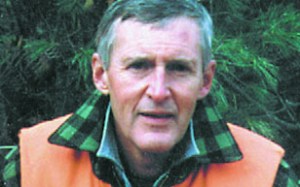If you have never tried matching your wits with a spring gobbler you don’t know what you are missing. A typical hunt for longbeards goes something like this:
Opening day of Maine’s turkey season. Shuffling out of the sack at 3:30 a.m., I eat a quick breakfast and drive to a spot I know. After a short walk in the fog, I find my old spot under a big pine tree alongside a large field and, after, placing the decoys — three hens and a jake — about 20 yards from my ground blind, I hunker down.
The field is shrouded in fog that seems to thicken as daylight begins breaking on the eastern horizon. The eerie stillness is at last broken by a distant gobble, then another. A couple of fly-down yelps bring a response from the tom, or at least it seems to be answering my call off in the distance. This goes on on for half an hour. Decision time. Shall I move his way and try to cut the distance or stay put?
Move, I guess. Underdressed as I am and fighting a chill, moving will be a welcome change. But an inner voice tells me to tough it out, stay put. I do. Nothing, no sounds for about an hour. The fog begins to lift, and the sun works its way above the hemlock trees behind me. I lean back to soak up some warmth from the sun’s rays.
Then I spot some turkeys about 300 yards on the far end of the field. There are a few hens, a couple of jakes, and one strutter doing his thing. He looks to be a mature tom. A couple of clucks and a purr from my slate call brings his head my way for an instant, but then he is back at the business at hand. I decide to wait it out and observe the proceedings. Soon, one by one, the hens work their way back into the woods.
I give a couple of soft purrs. The strutter looks toward my decoys from across the field and to my delight begins inching his way across the field toward the decoys. Halfway across the field, he, and the three jakes trailing him. come to a full stop. Like a chorus line they all freeze in their tracks with their necks extended and eyes looking straight at me.
At 30 yards, it is obvious that this strutter is an elder jake. No beard that I can see, but a sizeable male turkey nonetheless. In full strut he follows the script, stopping beside my jake decoy, stretching his neck to the fullest and talking up a storm.
To shoot or not to shoot. A second or two to decide. BLAM. I put him down with my little Remington 20-gauge pump. A trophy hunter would probably turn down the shot, waiting for a true trophy bird with a brag-worthy beard.
Not me. The script is flowing just too good to stop the cameras. The choreography and the orchestration is flawless. The crescendo in the turkey woods had risen to a perfect pitch. The kettle drums rolled and the cymbals clashed to complete the metaphor. There had to be a shot. After all, killing a turkey is the name of the game. His sacrifice leaves me with a memorable hunt and a wonderful meal or two.
Turkey season opens in most areas May 2 and goes to June 4th. You must have a big license or, new this year, a small game license and a turkey permit. Hunt starts a half hour before sunrise and ends an hour after sunset. The bag limit in WMDs 7 and 9-29 is two male birds (bearded). Special rules apply in northern Maine in WMDs 1-6 so check the law book.
If you are a trophy minded sportsman bent on bagging the “big fella,” heed the words of Maine turkey expert Stu Bristol: “True “turkey chasers” will seek out boss or dominant males and pass on other members of the flock. They will shun the local hotspots and instead take advantage of the trend that flocks expand their range by five or so miles each winter, going into the spring mating period.
Instead of hunting flocks in the lush meadows, we sink deeper into the forest in search of “woodland” gobblers that rarely show up in roadside meadows. In doing so, we eliminate most of the turkey hunter interference and enjoy a one-on-one conversation with “the big ones.”
V. Paul Reynolds is editor of the Northwoods Sporting Journal. He is also a Maine Guide, co-host of a weekly radio program “Maine Outdoors” heard Sundays at 7 p.m. on The Voice of Maine News-Talk Network (WVOM-FM 103.9, WQVM-FM 101.3) and former information officer for the Maine Dept. of Fish and Wildlife. His e-mail address is [email protected] . He has three books “A Maine Deer Hunter’s Logbook,” “Backtrack,” and his latest, “The Maine Angler’s Logbook.” Online purchase information is available at www.maineoutdoorpublications.com.

Comments are no longer available on this story